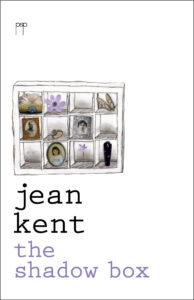 Reviewed by Magdalena Ball
Reviewed by Magdalena Ball
The Shadow Box
By Jean Kent
Pitt Street Poetry
April 2023, Paperback B format, 156 pages. ISBN 978-1-922776-04-4, A$28.00
Jean Kent’s poetry is so understated and subtle that it’s easy to miss how great a mastery she has. Her books seem to always come from a core of deep stillness. This kind of gaze is powerful, transfiguring and building cumulative meaning slowly, working its way into the reader’s consciousness where it remains. I’ve liked every book of hers that I’ve read, and it’s possible that I’ve read them all, but I think that The Shadow Box, which was inspired by her maternal grandparents George and Florence ‘Jean’ Campbell and the letters they wrote to one another and which were miraculously kept, is my favourite so far. The Shadow Box moves between past and present in a way that feels seamless. The poems place you in the moment of action; in the role of grandmother or grandfather with all of the pain and longing of separation and war and the joy of young love, exploration and parenthood while simultaneously taking the perspective of a modern day voyeur whose perspective is charged by empathy and DNA.
The book is scaffolded by two sections that are set in the present day: “Travels with My Grandmother” and “Inheritance”. “Travels with My Grandmother” begins with artefacts, a hall stand, a hat, a discarded tennis racquet, old photographs, or a silk maternity cape stowed in a drawer, all of which are portals to the moments they’ve captured:
Polishing this history takes patience.
I travel at the slow speed
of a ripening seed—
My hand gloved in the slow cloth, nestled
In the carved open hands of the Kurrajongs,
the closest I may ever get to being back
In that silenced time. (“Polishing the Kurrajong Hallstand”)
We sense in these black and white images (“really it is all greys”) or the yellowing letters that have been kept safe for so many years, some opening by which we can access the emotion and sensations of the past, or as Kent so perfectly puts it in “A Photo from Ismailia, 1916”, where the “parallel life of a dream/become real”.
The middle of the book is more or less in chronological order, progressing sequentially through each year of World War 1, from 1914 when her grandparents were married, to her grandfather’s rapid departure for the “wild sideshow alley of war” to his return and re-integration into his family through 1919. Kent has a particular gift for connecting the daily details of domestic life, what might be minutiae if they weren’t elevated through poetry-to the progression of the war effort, making the intimate connection between the micro and the macro visible. The story of these two characters George and Jean is an engaging one, and Kent does a marvellous job of connecting the dots and tracing their journeys, which sometimes bisected, through this period. So much is often happening at once, for example, the way in which George longs for his paddocks in Queensland while standing before a “cannon-blasted Gallipoli”:
If he stepped off the verandah
with his face towards those first spits, the scent
of water in dust should shiver him like the lucern,
dropping its violet-bruise flowers above black,
cracked earth. (“Distant Thunder”)
The poetry is often epigraphed by a snippet from a letter, either from George to Jean or Jean to George, charged by its setting as the characters move from Australia through Gallipoli, Egypt, Paris, and Palestine. The result is a tender ekphrastic that utilises these artefacts: a wedding dress, a hat, diary entries, letters, or a pressed flower to bring the past into the present, connecting the generations. Kent gets us under the skin of her grandmother as she walks down a street in Paris:
Summer…but still it’s jacket weather.
Under the horse chestnuts by the river,
When wind undoes al of the tree’s buttons (“Paris…is a beautiful place…”)
The work is full of Kent’s careful observations of the natural world but there is also an underlying horror, something that perhaps was never spoken of. Instead we have a sense of experiencing, rather than hearing about, trenches, privations and bullets, fear and violence, sometimes with a rhyming metre that calls to mind the fraught verses of Wilfred Owen:
bitter with this other knowledge on shivered flesh:
sometimes the difference between life and death
Is just a cat’s whisker twitch—nerves tuned to danger
That drop a body to the earth before an exploding
end of all time. Beneath the flash and the burn,
such narrow, narrow escapes. (“Swimming with Shrapnel”)
The final section, “Inheritance”, picks up on the book’s title and brings us back to the present via a series of shadow boxes or display cases (“genies’ lamps/waiting to bring back lives with one rub.”). These are boxes that may or may not exist anymore outside of memory, which we know to be unreliable:
or do I mean casuarinas? Sometimes my memory
of that place is a snow dome. When I turn it
upside down and shake it, I see only glittering flakes…(“A Sitting Room”)
Kent does a beautiful job of tying the book together in this section with poems that explore, in such a delicate hand it feels like we too are looking through a pane of glass, grief, loss, the impact of war, and perhaps just what is left from our living–what does it meant to have come and gone–the ultimate question:
Into the silence of myself
This focused capturing demands. (“Inheritance”)
The Shadow Box is an assured work that manages the most exquisite of magic tricks. It reminds the reader that there is no such thing as the past, and that history is what we are creating in the present through the artefacts we preserve, tracking a route from one timeframe to another via connection and love.